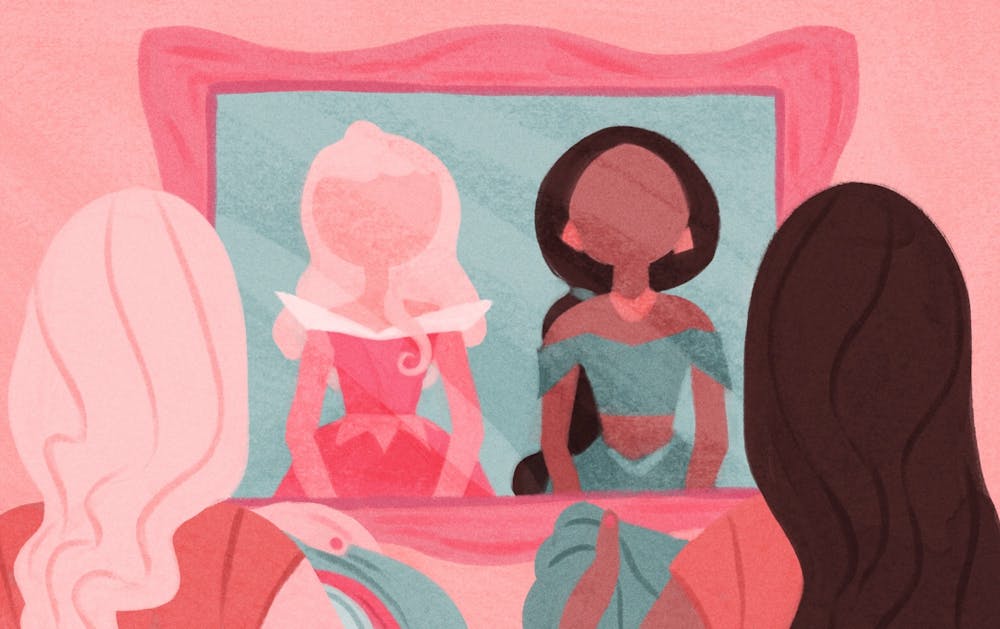Fairytale-themed event places are known and adored for their charming aesthetic and picture-perfect glamour. But behind the break-room doors hide behaviors far less wholesome.
The toxic environment that can fester among the staff members is a stark contrast to the quaint image we portray. When we aren't waving at parades and singing at birthday parties, we're body-shamed, castigated and dehumanized.
Vaishalini: Tokenizing Minorities
My job depended entirely on whether Brown characters were valued. I’ve worked under an owner that advertised Princess Jasmine along with other princesses of color, hoping to create as many equal opportunities for me to work.
I’ve also worked under an owner who chose to push white princesses like Snow White and Cinderella more, making work limited for the rest of us. Demand for princesses of color is already low because of parents’ prejudices, but when the boss chooses to showcase only white characters, there’s really no reason for the rest of us to be hired.
Watching a rotation of my white colleagues move through characters that I had the vocal abilities for but was regrettably “too ethnic” to play was already frustrating, but seeing the same colleagues often play the few characters of color that represented our communities was incredibly disheartening.
The hypocrisy of racebending from white to Brown or white to Asian but refusing to do so in the opposite way in order to give actresses of color the opportunities to play major roles is common in these theatre, performance-based businesses. If a white actress can play Moana or Elena of Avalor, why shouldn’t we be able to play characters like Rapunzel or Cinderella?
The issue goes deeper than individual company policy, however.
Disney has seven white, European princesses, but only one Asian princess, one Black princess, one Middle Eastern/South Asian princess, one Indigenous princess and one Polynesian princess.
The majority of princesses represent one continent while the rest act as tokens of their races, perpetuating the idea that characters of color are nothing but representations of their races.
This tokenization can be seen in off-brand, Disney-inspired party places as well.
White princesses’s names are changed creatively to “the Snow Queen,” “the Rose Princess,” or “the Seashell Princess,” while the other princesses are reduced to names like “Arabian Princess,” “Latina Princess” or “Island Princess.”
White princesses are not tokenized because there are so many of them. For example, Cinderella cannot be named “the French Princess” because there are three different French princesses.
The irony is that while Disney is happy to provide so many European princesses, they smushed together Middle Eastern and South Asian cultures to create a token character like Princess Jasmine, instead of putting in the effort to create real representation.
If you are going to tokenize minority communities, the least you can do is actually create a culturally accurate representation.
Hannah: Body Shaming
At the first princess job I worked at age 16, I was consistently told I looked anorexic and had the "body of a young boy." My boss and coworkers made jokes about my body and I laughed it off, even making jokes myself to ease the tension from the situation. But what they considered light-hearted teasing quickly developed into body shaming.
At one point, my boss made me wear false breasts in order to look “more womanly” and stuffed my top with socks when I was getting ready to work a party, which I had to actively try not to cry during. I left feeling awful about myself and my body and it didn’t stop there.
I often worked long days from before 9 a.m. to after 6 p.m. without eating any real food in between. This was conflicting for me because I was only given a piece of cake after the entire work day while I was simultaneously told I needed to eat more so I "didn’t look so thin."
After working there for a year I began realizing I didn’t know if I was thin enough, and I still struggle with body image issues including body dysmorphia.
I began working for a different company in 2019 and they took my concerns seriously. The owner constantly uplifts us to feel good about ourselves and makes active strides to avoid having us compete with each other by giving everyone the same hours every month.
However, there are still issues that even a great, compassionate employer cannot fix. This is because our experiences reflect the bigger problems of a lack of representation of races and ethnicities and body types within the princesses themselves.
From what I've experienced, these issues are so common in the princess industry because of the overarching, unrealistic and non-inclusive beauty standards within the characters themselves.
I would not have been pushed to be a certain weight or have a certain figure if the princesses themselves were more inclusive with body types. These characters instill unrealistic waistlines and beauty standards, and it doesn’t just affect us in the industry.
A 6-year-old girl told me she wanted to lose weight and wake up looking like a princess as her birthday wish. It was disheartening to tell a 6-year-old that she already was a princess and hear her insist she couldn’t be just because of her weight.
By ignoring these industry-wide problems, we are inevitably allowing more and more young, impressionable children to feel like they aren't enough — when we should be actively working to address the lack of representation.
The effects of this on a child are not always short term. I still carry the body image issues put in place by these characters and employers when I was 16 years old. I can only hope the 6-year-old has a different experience than I did and grows to love and appreciate herself in a way I never could.
Reach the reporters at hfoote1@asu.edu and vaishalini@asu.edu or follow @foote_hannah and @thevaishalini on Twitter.
Like The State Press on Facebook and follow @statepress on Twitter.




